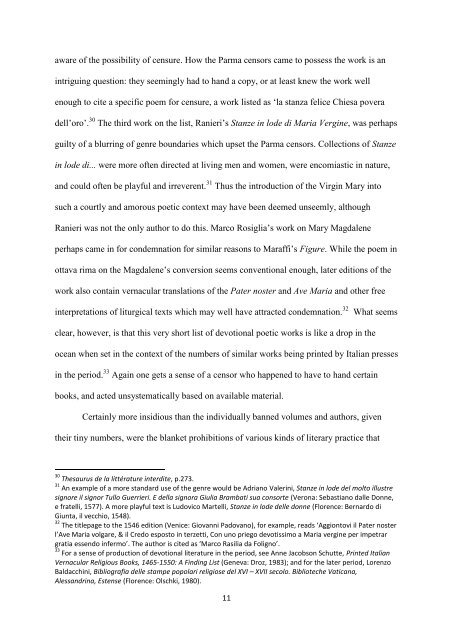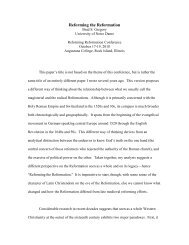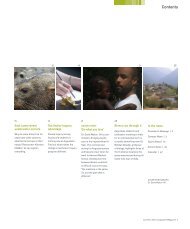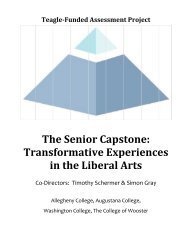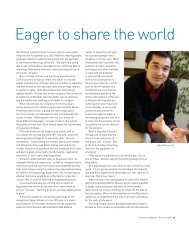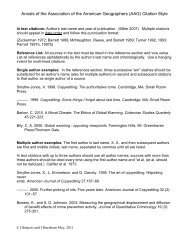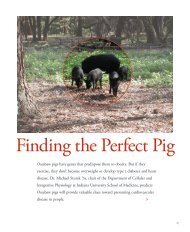Re-Writing Trent, or What Happened to Italian Literature in the Wake ...
Re-Writing Trent, or What Happened to Italian Literature in the Wake ...
Re-Writing Trent, or What Happened to Italian Literature in the Wake ...
Create successful ePaper yourself
Turn your PDF publications into a flip-book with our unique Google optimized e-Paper software.
aware of <strong>the</strong> possibility of censure. How <strong>the</strong> Parma cens<strong>or</strong>s came <strong>to</strong> possess <strong>the</strong> w<strong>or</strong>k is an<br />
<strong>in</strong>trigu<strong>in</strong>g question: <strong>the</strong>y seem<strong>in</strong>gly had <strong>to</strong> hand a copy, <strong>or</strong> at least knew <strong>the</strong> w<strong>or</strong>k well<br />
enough <strong>to</strong> cite a specific poem f<strong>or</strong> censure, a w<strong>or</strong>k listed as „la stanza felice Chiesa povera<br />
dell‟<strong>or</strong>o‟. 30 The third w<strong>or</strong>k on <strong>the</strong> list, Ranieri‟s Stanze <strong>in</strong> lode di Maria Verg<strong>in</strong>e, was perhaps<br />
guilty of a blurr<strong>in</strong>g of genre boundaries which upset <strong>the</strong> Parma cens<strong>or</strong>s. Collections of Stanze<br />
<strong>in</strong> lode di... were m<strong>or</strong>e often directed at liv<strong>in</strong>g men and women, were encomiastic <strong>in</strong> nature,<br />
and could often be playful and irreverent. 31 Thus <strong>the</strong> <strong>in</strong>troduction of <strong>the</strong> Virg<strong>in</strong> Mary <strong>in</strong><strong>to</strong><br />
such a courtly and am<strong>or</strong>ous poetic context may have been deemed unseemly, although<br />
Ranieri was not <strong>the</strong> only auth<strong>or</strong> <strong>to</strong> do this. Marco Rosiglia‟s w<strong>or</strong>k on Mary Magdalene<br />
perhaps came <strong>in</strong> f<strong>or</strong> condemnation f<strong>or</strong> similar reasons <strong>to</strong> Maraffi‟s Figure. While <strong>the</strong> poem <strong>in</strong><br />
ottava rima on <strong>the</strong> Magdalene‟s conversion seems conventional enough, later editions of <strong>the</strong><br />
w<strong>or</strong>k also conta<strong>in</strong> vernacular translations of <strong>the</strong> Pater noster and Ave Maria and o<strong>the</strong>r free<br />
<strong>in</strong>terpretations of liturgical texts which may well have attracted condemnation. 32 <strong>What</strong> seems<br />
clear, however, is that this very sh<strong>or</strong>t list of devotional poetic w<strong>or</strong>ks is like a drop <strong>in</strong> <strong>the</strong><br />
ocean when set <strong>in</strong> <strong>the</strong> context of <strong>the</strong> numbers of similar w<strong>or</strong>ks be<strong>in</strong>g pr<strong>in</strong>ted by <strong>Italian</strong> presses<br />
<strong>in</strong> <strong>the</strong> period. 33 Aga<strong>in</strong> one gets a sense of a cens<strong>or</strong> who happened <strong>to</strong> have <strong>to</strong> hand certa<strong>in</strong><br />
books, and acted unsystematically based on available material.<br />
Certa<strong>in</strong>ly m<strong>or</strong>e <strong>in</strong>sidious than <strong>the</strong> <strong>in</strong>dividually banned volumes and auth<strong>or</strong>s, given<br />
<strong>the</strong>ir t<strong>in</strong>y numbers, were <strong>the</strong> blanket prohibitions of various k<strong>in</strong>ds of literary practice that<br />
30 Thesaurus de la littérature <strong>in</strong>terdite, p.273.<br />
31 An example of a m<strong>or</strong>e standard use of <strong>the</strong> genre would be Adriano Valer<strong>in</strong>i, Stanze <strong>in</strong> lode del mol<strong>to</strong> illustre<br />
sign<strong>or</strong>e il sign<strong>or</strong> Tullo Guerrieri. E della sign<strong>or</strong>a Giulia Brambati sua cons<strong>or</strong>te (Verona: Sebastiano dalle Donne,<br />
e fratelli, 1577). A m<strong>or</strong>e playful text is Ludovico Martelli, Stanze <strong>in</strong> lode delle donne (Fl<strong>or</strong>ence: Bernardo di<br />
Giunta, il vecchio, 1548).<br />
32 The titlepage <strong>to</strong> <strong>the</strong> 1546 edition (Venice: Giovanni Padovano), f<strong>or</strong> example, reads ‘Aggion<strong>to</strong>vi il Pater noster<br />
l’Ave Maria volgare, & il Credo espos<strong>to</strong> <strong>in</strong> terzetti, Con uno priego devotissimo a Maria verg<strong>in</strong>e per impetrar<br />
gratia essendo <strong>in</strong>fermo’. The auth<strong>or</strong> is cited as ‘Marco Rasilia da Foligno’.<br />
33 F<strong>or</strong> a sense of production of devotional literature <strong>in</strong> <strong>the</strong> period, see Anne Jacobson Schutte, Pr<strong>in</strong>ted <strong>Italian</strong><br />
Vernacular <strong>Re</strong>ligious Books, 1465-1550: A F<strong>in</strong>d<strong>in</strong>g List (Geneva: Droz, 1983); and f<strong>or</strong> <strong>the</strong> later period, L<strong>or</strong>enzo<br />
Baldacch<strong>in</strong>i, Bibliografia delle stampe popolari religiose del XVI – XVII secolo. Biblioteche Vaticana,<br />
Alessandr<strong>in</strong>a, Estense (Fl<strong>or</strong>ence: Olschki, 1980).<br />
11


